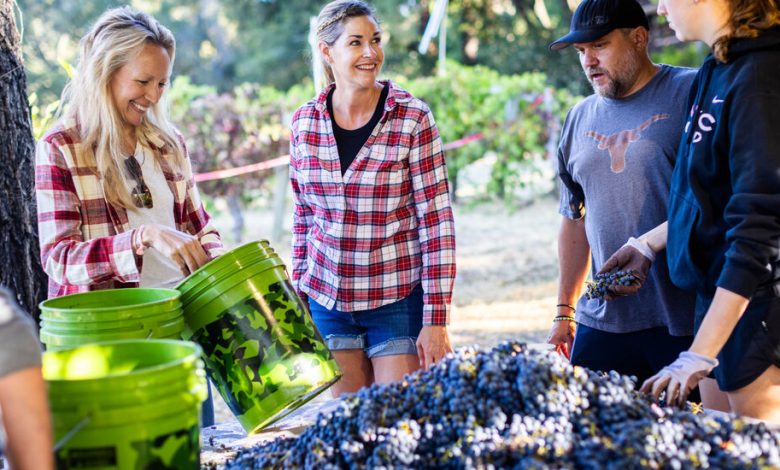The Agony and Ecstasy of Home Winemaking

The pickers began to arrive at 7 a.m. at the home of Greg and Emily Ernst in Geyserville, Calif., to help harvest their half-acre zinfandel vineyard before the October day reached its 95-degree high.
These are not professionals. They are family and friends for whom helping the Ernsts is an annual social highlight. The Ernsts, in turn, are not planning to sell their grapes. They are amateur winemakers who take great pleasure and pride in farming and fermenting grape juice into their own expression of zinfandel.
Throughout the morning, the 30 or so pickers, including seven children, filled plastic buckets with bunches of plump purple grapes. They deposited their hauls onto a table under bright lights, where Mr. Ernst culled the underripe or marred grapes, setting them aside to be stomped on by the children. He tossed the remaining bunches into a machine that would destem and crush them, yielding frothy purple juice and skins in a 30-gallon plastic vat.
This is the time of year when the Ernsts and thousands of other home winemakers are filling barrels, vats, carboys or whatever containers they can rustle up with fresh grape juice that will begin the slow transformation into wine in cellars, garages and sheds around the country.
No official numbers exist for precisely how many amateurs are making wine, said Brad Ring, publisher of WineMaker magazine, a periodical aimed at these hobbyists. But he estimated, based on sales of equipment and participation in competitions, that a half-million people are making wine in their homes in the United States and Canada.
The majority, he said, are on the West Coast, where — like Ralph Maltese, a semiretired supply-chain consultant in Santa Cruz, Calif. — they have ready access to a wide variety of wine grapes. In 2002, Mr. Maltese joined a group of a dozen or so hobbyists to form a winemaking cooperative. Together, they divided up tasks, some specializing in tasting or lab analysis. An oceanographer served as winemaker, while Mr. Maltese was the group organizer and cellar rat, a wine-industry term for those performing menial but essential tasks like topping off barrels.
Each year, they would arrange to buy a ton or so of grapes from vineyards up and down the California coast. Over time, they developed extensive contacts and would occasionally be offered free grapes.
“A guy who farmed for Gallo would call and say, ‘I got two acres of grapes I’m not picking, you want it?’” Mr. Maltese recalled. In 2018, the group, which called itself Cave Gulch Winery after Mr. Maltese’s Santa Cruz neighborhood, won a best of show at the Santa Cruz County Fair for a 2016 negrette, a red grape mostly grown in southwestern France. Sadly, they disbanded last year after the winemaker died unexpectedly.
The best part of it, Mr. Maltese said, was the togetherness.
“We would share equipment with a couple of other winemaking groups in town and get together for dinner,” he said. “When we had problems, like with a pinot noir, we’d call up one of the winemakers and ask how to approach it. People were great, it was a lesson in community.”
Americans have always made a little wine at home, particularly immigrants from wine-producing countries who wanted to reproduce a bit of the old country. But the practice really took off during Prohibition, when the authorities created an exception for home winemakers, who were permitted to produce up to 200 gallons a year. Vineyards were able to stay in business catering to them. Cesare Mondavi, father of Robert Mondavi, moved his family from Minnesota to California in 1923 to start a business selling grapes, largely to home winemakers.
The 200-gallon household limit persists today, and winemakers are not permitted to sell their wares. Most give it away to friends and family, enter amateur winemaking competitions sponsored by WineMaker, the American Wine Society and numerous local entities, while stashing some away to see how the wines evolve.
Not everyone is lucky enough to have their own vines or live near Wine Country. They, like Cesare Mondavi’s customers, will order fresh grapes to be shipped, or buy frozen grapes or grape juice.
Lisa Nordmann in Fenton, Mo., was inspired by her son Timothy’s winemaking efforts and in 2015 took up the challenge. Her first try, with cayuga, a white hybrid grape, did not turn out well as the juice oxidized in the heat of her garage. But they soon got serious.
“My husband and Tim built a cool wine room so we could do long, slow fermentations,” she said. “It needs to be cool, especially with whites, so you can get the aromas and flavors.”
Soon, they were winning competitions, primarily with hybrid and native varieties that are grown in the Midwest, like norton, chambourcin, traminette and vignoles. But she also buys syrah or cabernet sauvignon juice from California or Chile. She’s served as president and secretary of the Missouri Winemaking Society, and she travels to conventions of winemakers.
“You learn a whole lot talking to others,” she said.
Making wine is not a cheap hobby. Ms. Nordmann says she’s spent thousands of dollars on equipment, including a bladder press, a crusher-destemmer, various vats, barrels and carboys, pumps, bottle fillers and ingredients like yeast.
That doesn’t include the grapes or juice. Ms. Nordmann can pay roughly $72 for 72 pounds of fresh Missouri hybrids, which would yield five gallons of wine. For California grapes, Musto Wine Grapes in Hartford, Conn., charges $98 for 72 pounds of cabernet sauvignon from Lodi, Calif. Six gallons of Lodi cabernet juice, which also makes five gallons of wine, would run $60. Shipping would be extra, and would depend on many factors to arrive at a price. Of course, many serious amateurs aim for closer to the 200-gallon limit, so costs multiply.
Home winemakers are a diverse group, but many have a scientific or scholarly bent. Gordon W. Gribble in Norwich, Vt., taught chemistry at Dartmouth College for more than 55 years, and has been making wine for almost as long.
The most memorable wine he’s made, he said, was a 1995 petite sirah. He came upon the grapes serendipitously at a winery in New York, which had crushed and stored them a year before. He brought them home and made the wine. He liked it so much he entered it in an American Wine Society competition in 1998, and “the judges went wild.”
Lou Camilotto, a retired geography teacher in West Lafayette, Ind., has made all sorts of wines, but particularly enjoys making blueberry wines. He gives away most of it.
“The fun is making it, deciding what to create and when it’s ready,” he said. He was inspired by watching his grandfather, an Italian immigrant, make it at home. Like many avid amateurs he belongs to a club, the Tippy Tasters of Tippecanoe County, which offers social and networking opportunities and entree to winemaking conventions and seminars.
Mark Diehl, who started making wine with his wife, Sandi, at home in Kennesaw, Ga., said conventions often include a seminar entitled, “So You Think You Want to Go Pro,” for those fantasizing about the wine business. The usual message: “Don’t.”
The Diehls, both retired physicians, didn’t listen. When their friends, who owned Stonewall Creek Vineyards in Tiger, Ga., near the South Carolina border, decided they wanted to retire, the Diehls bought it. They now produce 1,200 cases or so a year of wines made of both hybrids and French grapes like petit verdot and cabernet franc, with Mr. Diehl making the wine. He has also had to learn about growing grapes and dealing with government bureaucracy.
“It’s been a learning process,” he said, “with an unending amount of paperwork!”
For those who’d like to make wine, but want guidance, options are available like Make Wine With Us in Wallington, N.J., where customers can select their level of participation.
Some want to do everything, from destemming the grapes to bottling, said John Grizzi Jr., the proprietor. Others simply want bottles with their own personal label, which they can use as promotional products for their businesses. Make Wine will operate the equipment, store the wine and offer classes, recipes and any other help people might need.
“We have a couple hundred groups that come in, from an individual or couple to 30 or 40 people, families, friends, co-workers,” Mr. Grizzi said.
Back in Geyserville, the Ernst harvest was winding down by 10:30 a.m., and the beer, homemade I.P.A. by Mr. Ernst’s brother Eric, was flowing.
Many were tasting past vintages of E&E zinfandel, for Ernst and Ernst. The 2018 was elegant, fresh and delicious with a note of licorice. The vats of juice were safe, settling in the shed. That night, yeast would be added and the fermentation would begin. The wines will be bottled in roughly 14 months.
As the guests reflected on the beauty of this pastoral pastime, Mr. Ernst was off to the side, hosing down and storing away the sorting table and machinery, a reminder that wine is not always glamorous.
Follow New York Times Cooking on Instagram, Facebook, YouTube, TikTok and Pinterest. Get regular updates from New York Times Cooking, with recipe suggestions, cooking tips and shopping advice.



